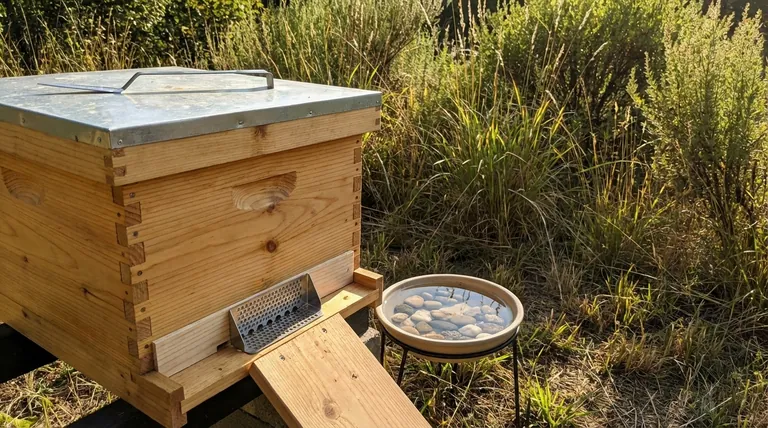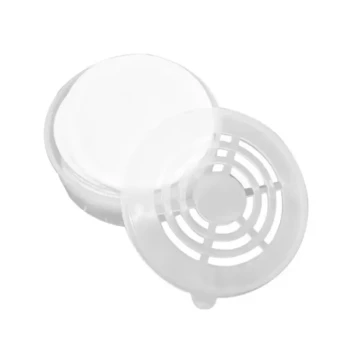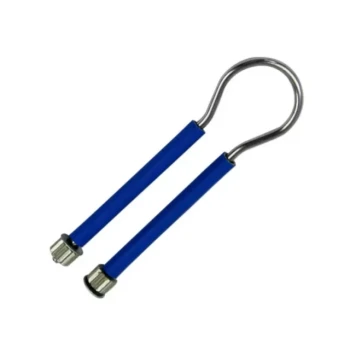Beyond providing food, a new hive's survival depends on your ability to protect it from a specific set of external threats. Key protective measures involve defending against pests and predators, mitigating the effects of severe weather, avoiding pesticide exposure, and preventing other insects from robbing the hive's resources.
The core task of protecting a new colony is not just about adding equipment, but about creating a controlled, low-stress environment. Your goal is to minimize external pressures so the bees can focus their energy on building comb, raising brood, and establishing a resilient population.

Shielding Against Pests and Predators
A new, small colony is an attractive and easy target. Proactive defense is critical during the first few months as the population grows and establishes its own defenses.
The Threat of Robbing
Robbing occurs when strong hives or other insects like wasps discover your new hive's honey stores and overwhelm its small population to steal them. This is a primary threat to a new colony's survival.
The most effective defense is an entrance reducer. By shrinking the hive entrance to a very small opening, you allow the colony's few guard bees to effectively defend their home against intruders.
Managing Pests and Brood Diseases
Your most significant and persistent pest will likely be the Varroa mite. These parasitic mites weaken bees, transmit viruses, and can cause a colony to collapse.
Even a new package of bees can have Varroa. You must have a plan for monitoring mite levels early on and be prepared to treat them if necessary to ensure the long-term health of the hive.
Defending Against Larger Predators
Mice often seek shelter in hives during the fall and winter, where they can destroy comb and contaminate the hive. A simple mouse guard installed over the entrance in autumn prevents them from getting inside.
For larger predators like skunks or bears, elevating the hive on a sturdy stand can deter some, while an electric fence may be necessary for others, depending on your location.
Mitigating Environmental Dangers
A hive's location and orientation can dramatically impact its ability to handle environmental stress, which is especially taxing on a new colony.
Protecting from Severe Weather
Place your hive in a location that receives morning sun to encourage early foraging but has some protection from intense afternoon heat. A windbreak, such as a fence or shrub line, is also crucial for protecting the hive from cold winter winds.
Ensure a consistent and clean water source is nearby. Bees use water to cool the hive in hot weather, and a new colony may struggle if it has to expend too much energy flying long distances for it.
Navigating the Risk of Pesticides
Pesticide exposure can wipe out a foraging force or an entire colony. Be mindful of nearby agricultural fields, orchards, or even neighborhood lawn care practices.
Position your hive as far from these potential sources as possible. Building good relationships with neighbors can also be helpful; ask them to notify you before they spray so you can temporarily close up your hive.
Understanding the Trade-offs
Every protective measure has an implication, and understanding the balance is key to effective beekeeping.
The Entrance Reducer Dilemma
While essential for preventing robbing in a new hive, an entrance reducer also limits the flow of foragers. As your colony grows stronger, you will need to expand the entrance to prevent traffic jams and ensure adequate ventilation.
Intervention vs. Observation
New beekeepers are often tempted to inspect their hives too frequently. Every inspection disrupts the colony's work and temperature regulation. Limit your inspections to what is necessary, focusing on confirming the queen is laying and the colony has enough food and space.
Your Hive Protection Checklist
Your immediate actions should be guided by the most pressing threats to a new, vulnerable colony.
- If your primary focus is immediate survival: Prioritize installing an entrance reducer to prevent robbing and ensure the hive is secure from predators like mice.
- If your primary focus is long-term health: Establish a plan for monitoring and managing Varroa mites from the very beginning, as they are the single greatest threat to colony health.
- If your primary focus is environmental stability: Carefully select your hive's location for proper sun exposure, wind protection, and safe distance from potential pesticide use.
By anticipating these challenges, you shift from simply keeping bees to actively guiding your new colony toward resilience and strength.
Summary Table:
| Threat | Key Protective Measure | Purpose |
|---|---|---|
| Robbing (Wasps/Other Bees) | Use an Entrance Reducer | Allows small guard force to defend the hive |
| Varroa Mites | Implement Monitoring & Treatment Plan | Prevents weakening and collapse from disease |
| Mice | Install a Mouse Guard (Autumn) | Blocks entry and prevents comb destruction |
| Severe Weather | Provide Windbreak & Morning Sun | Protects from cold winds and regulates temperature |
| Pesticides | Choose Location Carefully & Communicate | Minimizes risk of poisoning the foraging force |
Equip your new hive for success with HONESTBEE. Protecting your investment starts with the right equipment. As a trusted wholesale supplier to commercial apiaries and beekeeping equipment distributors, we provide the durable, effective tools you need—from entrance reducers and mouse guards to mite monitoring supplies—to build a resilient colony. Contact our experts today to discuss your hive protection needs and wholesale pricing.
Visual Guide

Related Products
- HONESTBEE Professional Long Handled Hive Tool with Precision Cutting Blade
- Professional Multi-Function Stainless Steel Hive Tool
- Wholesales Dadant Size Wooden Bee Hives for Beekeeping
- Professional Insulated Plastic Bee Hives
- Ventilated Adult Beekeeping Helmet Hat for Beekeepers
People Also Ask
- How can a hive tool be used to remove propolis and burr comb? Master Hive Maintenance for a Healthy Colony
- What is the hive tool used for? The Essential Multi-Tool for Every Beekeeper
- What is a hive tool and what are its uses? Master Your Hive Inspections with the Essential Beekeeper's Tool
- How should beekeepers handle bees when using a hive tool? Master Calm, Deliberate Techniques
- What tools are used for cleaning frames? A Beekeeper's Simple 4-Tool Guide



















